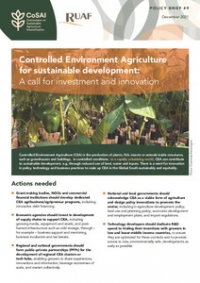A version of this appeared as a WLE commentary on One Earth
Falling in the midst of global crises, this month's World Environment Day brings home the need for a transformation in the ways we approach food systems, land management, and stewardship of our Earth.
A highly efficient virus has thrown the world into chaos. And how we manage our Earth, its land and our food systems appear to be inextricably linked to this crisis. We must look hard at some key culprits - ecosystem destruction, biodiversity loss, and unsustainable farming systems – and urgently commit to change. We cannot afford business as usual.
Before this crisis struck, we had been been witnessing a growing global impetus for action on climate and environment. It’s driven by the realization that decades of effort have fallen short, and that we have both a climate crisis and a full-blown planetary emergency! And the way we use land is at its center.
Radical solutions are gaining traction, but they can bring new risks that hamper progress. Well-meaning solutions, such as securing commitments to zero land expansion or boycotting unsustainable agricultural products, do not always consider impacts on some of the world’s poorest groups. The most vulnerable have long borne the burden of environmental harm, so they shouldn’t also pay the costs of solving the crisis. And they should be included in designing the solutions.
Agriculture is struggling to keep up with rapidly changing needs and demands, whether more food for growing urban populations, or environmental services, or providing sufficient livelihoods and nutrition. And these functions would be further undermined if we do not make serious changes to the ways we approach land management and agricultural production.
Unsustainable land use practices on a local scale are not the cause of our environmental crisis. Local unsustainability and global environmental crises are both symptoms of the same often ill-equipped agricultural systems. The systems, in fact, often incentivize unsustainability and perpetuate inequality. With demographic, economic and environmental contexts continually shifting dramatically the last few decades, agriculture simply cannot keep up if it is out of date. Progress has lagged in comparison to other sectors like energy.
Other solutions focus on single problems and neglect interlinkages, for instance, demand for biofuels taking land away from food production. Or large hydropower dam construction that provides energy, but often floods landscapes and harms agriculture and fisheries. Or agricultural land expansion that forces animals into close contact, risking zoonotic disease outbreaks like COVID-19.
These complex interdependencies and relationships can be a challenge to understand and manage. But any truly sustainable vision for land use change must integrate an understanding of the necessary trade-offs, and must not overlook economic and social sustainability, as economic growth neglected the environment.
It is difficult to develop such land-use solutions that satisfy the diverse needs of health, environmental sustainability, food security, social equity, and economic needs. And it is not enough to encourage good practice despite structural constraints – it is also necessary to tackle these constraints to create a new network of incentives that build a self-perpetuating culture of sustainable land use.
But there are glimmers of hope – for instance, CGIAR’s solar-irrigation innovations delivers an alternative to carbon-inefficient diesel pumps, while providing financial incentives to farmers to prevent over-pumping of water, while delivering returns to governments. And in Colombia, cattle farmers receive low interest loans to convert degraded pastures into healthy, rehabilitated, multi-use lands. This stops farmland from expanding into areas that used to be Amazon rainforest.
Promising solutions like this are sprouting up worldwide, and can be scaled outward and upward with the right incentives and investments. WLE is launching a Commission on Sustainable Agricultural Intensification (CoSAI) to examine just how to do so.
The key barrier to sustainability is the lack of such integrated incentive-based solutions, but also the policy and institutional inertia that prevents such techniques from being scaled up. Local solutions are important, but transformation of broader structures is absolutely necessary to make the jump from localized short-term interventions to systemic change.
As the world confronts a crisis unlike nothing we’ve seen in our lifetimes, it’s clear we need to move on these system transformations. The Earth’s health, our food systems, and the health of ourselves and our most vulnerable populations depend on it.
---
Thrive blog is a space for independent thought and aims to stimulate discussion among sustainable agriculture researchers and the public. Blogs are facilitated by the CGIAR Research Program on Water, Land and Ecosystems (WLE) but reflect the opinions and information of the authors only and not necessarily those of WLE and its donors or partners.
WLE and partners are supported by CGIAR Trust Fund Contributors, including: ACIAR, DFID, DGIS, SDC, and others.



/index.jpg?itok=Rd9jvqMu)

















